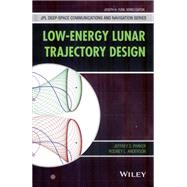- Surveys thousands of possible trajectories that may be used to transfer spacecraft between Earth and the moon, including transfers to lunar libration orbits, low lunar orbits, and the lunar surface
- Provides information about the methods, models, and tools used to design low-energy lunar transfers
- Includes discussion about the variations of these transfers from one month to the next, and the important operational aspects of implementing a low-energy lunar transfer
- Additional discussions address navigation, station-keeping, and spacecraft systems issues

Low-Energy Lunar Trajectory Design
by Parker, Jeffrey S.; Anderson, Rodney L.; Yeun, Joseph H.-
 eCampus.com Device Compatibility Matrix
eCampus.com Device Compatibility Matrix
Click the device icon to install or view instructions
Buy New
Rent Textbook
Rent Digital
Used Textbook
We're Sorry
Sold Out
How Marketplace Works:
- This item is offered by an independent seller and not shipped from our warehouse
- Item details like edition and cover design may differ from our description; see seller's comments before ordering.
- Sellers much confirm and ship within two business days; otherwise, the order will be cancelled and refunded.
- Marketplace purchases cannot be returned to eCampus.com. Contact the seller directly for inquiries; if no response within two days, contact customer service.
- Additional shipping costs apply to Marketplace purchases. Review shipping costs at checkout.
Summary
Author Biography
Jeffrey S. Parker, Ph.D., was a member of the technical staff at the Jet Propulsion Laboratory (JPL) from 2008 to 2012. Currently Dr. Parker is an Assistant Professor of Astrodynamics at CU-Boulder. His research interests are focused on astrodynamics, space exploration, and autonomous spacecraft operations.
Rodney L. Anderson, Ph.D., is a member of the JPL technical staff, where he is involved in mission design and navigation and develops new methods for trajectory design. His research interests are focused on the application of dynamical systems theory to astrodynamics and mission design.
Table of Contents
Foreword xi
Preface xiii
Acknowledgments xv
Authors xxi
1 Introduction and Executive Summary 1
1.1 Purpose 1
1.2 Organization 1
1.3 Executive Summary 2
1.4 Backgound 11
1.5 The Lunar Transfer Problem 12
1.6 Historical Missions 14
1.7 Low-Energy Lunar Transfers 23
2 Methodology 27
2.1 Methodology Introduction 27
2.2 Physical Data 28
2.3 Time Systems 29
2.4 Coordinate Frames 32
2.5 Models 35
2.6 Low-Energy Mission Design 41
2.7 Tools 114
3 Transfers to Lunar Libration Orbits 117
3.1 Executive Summary 117
3.2 Introducuton 120
3.3 Direct Transfers Between Earth and Lunar Libration Orbits 122
3.4 Low-Energy Transfers Between Earth and Lunar Libration Orbits 161
3.5 Three-Body Orbit Transfers 221
4 Transfers to Low Lunar Orbits 227
4.1 Executive Summary 227
4.2 Introduction 229
4.3 Direct Transfers Between Earth and Low Lunar Orbit 231
4.4 Low-Energy Transfers Between Earth and Low Lunar Orbit 233
4.5 Transfers Between Lunar Libration Orbits and Low Lunar Orbits 258
4.6 Transfers Between Low Lunar Orbits and the Lunar Surface 258
5 Transfers to the Lunar Surface 263
5.1 Executive Summary 263
5.2 Introduction for Transfers to the Lunar Surface 265
5.3 Methodology 267
5.4 Analysis of Planar Transfers between the Earth and the Lunar Surface 268
5.5 Low-Energy Spatial Transfers Between the Earth and the Lunar Surface 277
5.6 Transfers Between Lunar Libration Orbits and the Lunar Surface 294
5.7 Transfers Between Low Lunar Orbits and the Lunar Surface 298
5.8 Conclusions Regardingh Transfers to the Lunar Surface 298
6 Operations 299
6.1 Operations Executive Summary 299
6.2 Operations Introduction 300
6.3 Launch Sites 301
6.4 Launch Vehicles 301
6.5 Designing a Launch Period 304
6.6 Navigation 332
6.7 Spacecraft Systems Design 349
Appendix A: Locating the Lagrange Points 351
References 359
An electronic version of this book is available through VitalSource.
This book is viewable on PC, Mac, iPhone, iPad, iPod Touch, and most smartphones.
By purchasing, you will be able to view this book online, as well as download it, for the chosen number of days.
Digital License
You are licensing a digital product for a set duration. Durations are set forth in the product description, with "Lifetime" typically meaning five (5) years of online access and permanent download to a supported device. All licenses are non-transferable.
More details can be found here.
A downloadable version of this book is available through the eCampus Reader or compatible Adobe readers.
Applications are available on iOS, Android, PC, Mac, and Windows Mobile platforms.
Please view the compatibility matrix prior to purchase.

